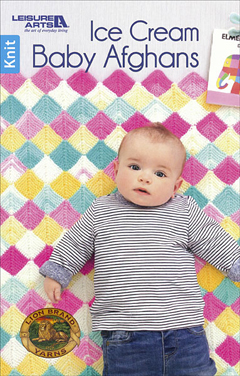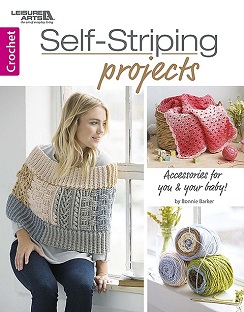Self-striping yarn is variegated yarn which has two or more colors that are engineered to easily create stripes when you knit or crochet with the yarn. Often there are long lengths of each color before the color changes to the next. When you crochet or knit with self-striping yarn, the yarn will typically create a striped project on its own, without you having to do any color changes.
What Is the Difference Between Variegated Yarn and Self-Striping Yarn?
Self-striping yarn is a type of variegated yarn. Variegated yarn is any yarn that has color or fiber variations; the yarn isn’t solid-colored or isn’t all consistently the same. Self-striping yarn falls into this category, but it isn’t the only type of variegated yarn. Self-striping yarn is specifically engineered to work up into striped projects when you knit or crochet with it. In contrast, many other variegated yarns have color repeats that are much shorter; it typically takes long expanses of each color for the yarn to work up into stripes.
What Are the Advantages of Working With Self-Striping Yarn?
Self- Striping Yarn Advantages:
It’s easy for total beginners to crochet or knitting to achieve colorful projects with a self-striping yarn. There is no need to remember to change colors when you work with this type of yarn, and no need to fumble with color changes.
Self-striping yarn is an excellent choice for crafters who are not confident in their abilities to choose yarn colors that will look amazing together. There is no need to stress over your color choices when you work with self-striping yarn; the manufacturer has most likely done a great job of picking harmonious colors. It’s also helpful when you’re purchasing yarn on the Internet, and you can’t see it in person before you buy it to get an idea whether or not the colors will work together well when you actually see them in real life.
Disadvantages of Self-Striping Yarn:
One downside to self-striping yarn is that you have no control over where the color changes fall; they might fall in the middle of rows or rounds. Sometimes the stripes created look nice and neat, but other times they could end up looking a bit sloppy or uneven.
Self-striping yarn tends to be more expensive than solid-colored yarn is. If the same yarn is available in both solid and self-striping colors, check and compare how many ounces of yarn you’re getting per ball in the solid vs the self-striping. You might find that both balls have the same retail price, but you might also find that you get less yarn in the self-striping ball.
It might take some experimentation to find a pattern that will work well with the yarn and crochet hook / knitting needles you have chosen to use.
Expect Surprises: When you work with any sort of variegated yarn, including self-striping yarn, your project is likely to turn out looking different than you’d expect. It’s going to look different in your project than it does when it’s a ball or hank of yarn setting on the store shelf.
I’m not sure whether to list this as an advantage or disadvantage, because it could go either way: It’s hard to predict whether you’ll be pleasantly surprised, or unpleasantly surprised. It depends on so many factors – the yarn, the pattern you’re using, the technique you’re using, the hook or needles you’re using, your individual taste, and so on.
Crocheters, Be Aware: I have no way to know this for sure, having never been a yarn manufacturer, but I have long suspected that many variegated yarns – including self-striping yarns – are developed with knitters’ needs and projects in mind. I’ve developed the habit of looking at projects the manufacturer has published using the yarn; if they’re all knitting projects, it gives me a clue that that’s the case. Which isn’t to say that the yarn might not work well in crochet projects – it might. But if I’m trying to decide between two different yarns for use in a crochet project, I’m likelier to choose a yarn that has a track record of having already successfully been used in crochet projects before.
Having said that, I can say that self-striping yarns, particularly those with long lengths between color changes, do tend to work well for crochet projects. In my opinion, it’s the variegated yarns with short lengths between color changes that you have to watch out for – those are hit or miss (often miss) for crochet projects.
Self-Striping Yarn Patterns:
Some of My Favorite Patterns for Knitting and Crocheting With Self-Striping Yarns:
There are two excellent books I can highly recommend if you are interested in knitting or crocheting with self-striping yarns. The first is Ice Cream Baby Afghans: 9 Baby Blanket Knitting Patterns Using Variegated Yarn. This book is intended to give you a variety of 9 different baby blanket knitting patterns that all utilize a specific brand of self-striping yarn: Lion Brand’s Ice Cream Yarn, which is a variegated acrylic yarn that comes in a baby-friendly color palette comprised mostly of pastels and brights mixed with some white.
The other book you might like to know about is a crochet pattern book called Self-Striping Projects by Bonnie Barker. Last I checked, it was out of print, although the publisher, Leisure Arts, does often do new print runs of beloved older titles. So it is possible that this book might become available again in the future; I do not know. But, in the meanwhile, you can sometimes find used copies of it available for sale on the secondary market. If you’re interested in owning a copy of this book, I recommend checking for used copies of it at Amazon.
Related Resources
Posted By: Amy Solovay
This page was last updated on 8-19-2023.

